100 ECG’s
Systemic disorder ECGs: (23 questions)
Questions
-
1
52 year old woman with a history of hypertension receives the news of the death of her son who is a soldier in the army and starts experiencing chest pain. She phones the ambulance immediately who perform an ECG en-route to hospital (ECG shown). She is immediately taken to the cath lab, where an angiogram is performed and shows normal left and right coronary arteries. However, there is marked “ballooning” of the left ventricle during systole. What is the diagnosis? 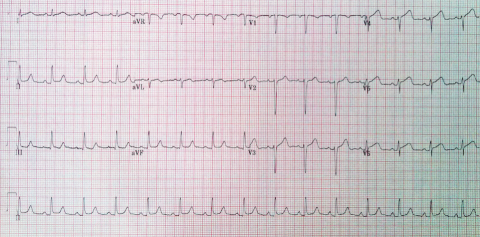
a Co-incidental ST elevation MI b Dilated cardiomyopathy c Tako-tsubo cardiomyopathy d ST elevation MI precipitated by stress e Hypertrophic obstructive cardiomyopathy (HOCM) -
2
A 51 year old builder presents to the emergency department with nausea, dizziness and a headache. He has a family history of ischaemic heart disease and is a current smoker of 40 cigarettes per day. His past medical history includes hyperlipidaemia, diabetes mellitus (diet controlled), polycystic kidney disease and hypertension. His ECG is shown. What is the diagnosis ? 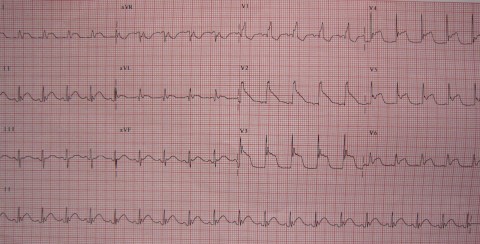
a Non-ST elevation MI in antero-lateral heart b Old antero-lateral MI c Unstable angina d Subarachnoid haemorrhage e Idiopathic Intracranial Hypertension -
3
A 30 year old cyclist is brought in following a road traffic accident. He was hit by a car and has bruises on his arms, chest, thighs and back. He was noted to have a heart rate of 146 and a blood pressure of 80/40. His heart sounds were distant and his JVP was raised. His ECG is shown. What is the diagnosis ? 
a Acute myocardial infarction b Cardiac Tamponade c Infective endocarditis d Aortic dissection e Myocardial contusion -
4
A medical student examines a newly admitted patient who is complaining of a productive cough. The patient is 35 years old with a history of bronchiectasis and the working diagnosis is an infective exacerbation. The medical student examines the cardvascular system and hears distant heart sounds. The apex beat is impalpable. She performs an ECG next (shown). What is the cause of her findings ? 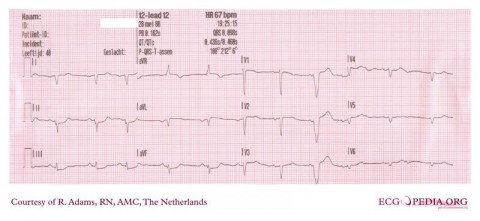
a Brugada Syndrome b Kartagener's syndrome c LAD syndrome d Dressler's syndrome e Tietze's syndrome -
5
A 75 year old lady is brought in by ambulance following a phone call from a concerned neighbour. She was found lying on the ground in her patio-garden for an unknown period of time. Her heart rate is 42 and is unresponsive. Her ECG is shown. What is the most likely finding on clinical examination ? 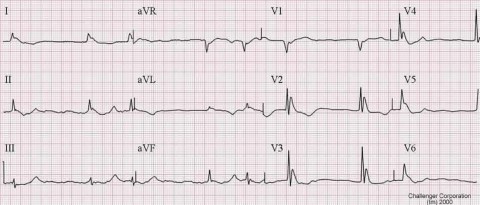
a Pericardial rub b S3 sound c Warm peripheries d Decreased muscle tone e Temperature 34.7 C -
6
A 31 year old woman is admitted to the emergency department after being found unconscious in her room by her partner next to an empty bottle of tablets. Her partner reports that they had a big fight earlier that day. He is unsure what she has taken but reports that she suffers from type 1 diabetes with neuropathy, depression, dependent personality disorder and asthma. Her BP is 80/46 and her ECG is shown. Which drug type has she ingested ? 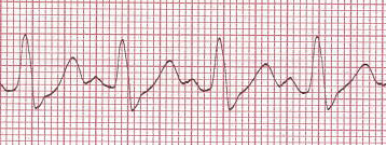
a Prednisone b Haloperidol c Monoamine oxidase inhibitors d Selective serotonin reuptake inhibitors e Tricyclic antidepressants -
7
A 68 year old lady attends the emergency department complaining of chest pain. The pain is described as a sudden onset sharp chest pain which does not change with position. She has no history of cardiac disease and does not smoke. Her only current medical condition is rheumatoid arthritis. On examination, her heart rate is 75, blood pressure 124/78, with some tenderness over her chest when you are trying to auscultate. Her ECG is shown. What is the diagnosis ? 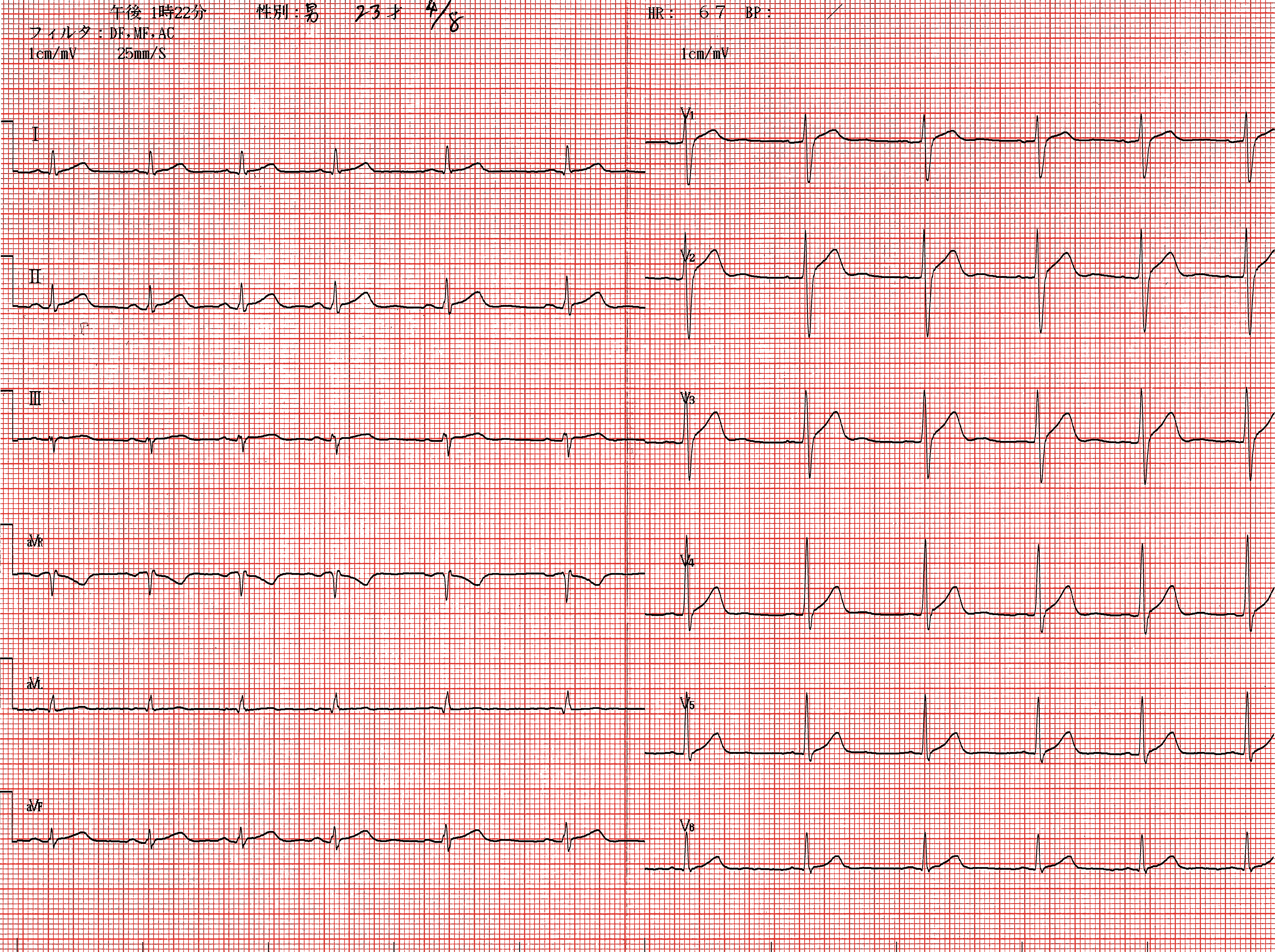
a Acute myocardial infarction b Brugada syndrome c Heyde's syndrome d Felty's syndrome e Tietze's syndrome -
8
A 19 year old basketball player attends the emergency department complaining of sudden onset sharp chest pain. The onset was 4 hours previously when he first woke up in the morning. The pain does not change with position, but increases slightly with inspiration. On examination, he has a BMI of 19, his repiratory rate is 16 and oxygen saturations are 100%. His heart rate is 80bpm and blood pressure 120/80. His ECG is shown. What is the likely diagnosis? 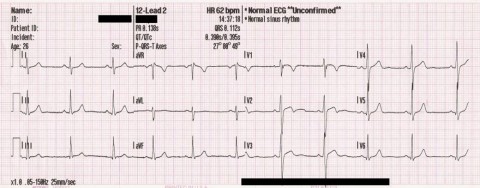
a ST elevation myocardial infarction b Angina pectoris c Pulmonary embolism d Spontaneous pneumothorax e Tension pneumothorax -
9
A 51 year old man is admitted to the emergency department complaining of sudden onset central chest pain. He is a current smoker and has a family history of cardiac disease. He has hypertension, hyperlipidaemia, diabetes mellitus type 2, and peripheral vascular disease. He describes his pain as a 6 out of 10 intensity which becomes 4 out of 10 when he sits forward. He has tried to take Gaviscon for it but that has not helped. ECG is shown. What is the likely diagnosis? 
a Acute global myocardial infarction b Acute Left main stem syndrome c Acute pulmonary embolism d Acute pericarditis e Acute pneumothorax -
10
A 23 year old woman comes to her GP complaining of sudden onset chest pain for 3 hours. The pain is sharp and is worse when lying down and improves when sitting forward. Her past medical history is neglible. Her son has recently acquired a cold-like illness. Her ECG is shown. What is the most likely diagnosis? 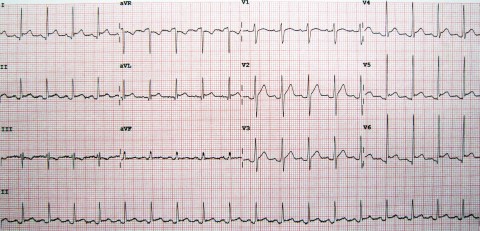
a Atypical pneumonia b Pericarditis c Pulmonary oedema d Acute myocardial infarction e Infective endocarditis -
11
A 45 year old woman attends the emergency department with new sudden onset central chest pain. She has a history of hypertension and menorrhagia for which she takes lisinopril and microgynon, respectively. She is worried she may have a chest infection as she has just come back from a trip to South Africa. On examination, she is short of breath and is tachycardic. Her ECG is shown. What is the diagnosis? 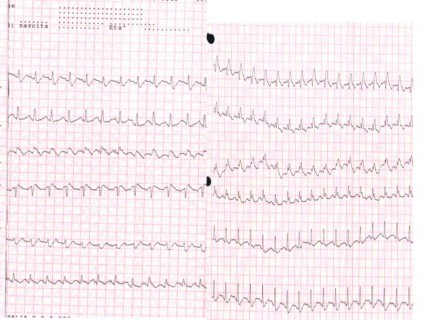
a Atypical pneumonia b Acute myocardial infarction c Infective endocarditis d Pulmonary embolism e Pericarditis -
12
A 52 year old woman with hypothyrdoism attends for follow up at her local GP practice. She has recently experienced weight loss and difficulty sleeping for three months duration. Her other medical conditions include atrophic gastritis and type 1 diabetes mellitus. She takes insulin, simvastatin, thyroxine and omeprazole. Her ECG is shown. What is the most likely diagnosis? 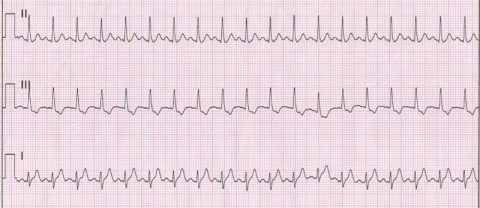
a Acute myocardial infarction b Iatrogenic hyperthyroidism c Pulmonary embolism d Pericarditis e Graves disease -
13
A 64 year old gentleman attends the cardiology clinic for follow up six weeks post a myocardial infarction. He initially had a heart attacked and stayed in hospital and was advised to stop smoking upon discharge. He is back today complaining of new onset of chest pain for a few days duration. His pain is sharp, in the centre of the chest, does not change with inspiration and is worse when he is lying in bed. He is still smoking and his risk factors remain the same with diabetes mellitus, hyperlipidaemia and hypertension. his ECG is shown. What is the most likely diagnosis? 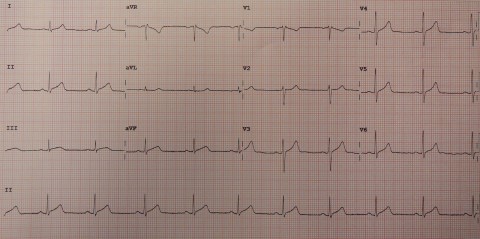
a Dressler's syndrome b Brugada syndrome c Acute myocardial infarction d Pulmonary embolism e No acute changes -
14
A 35 year old woman presents to her GP with central sharp chest pain of 4 hours duration. She has no medical history and her only medication is the combined pill. Her pain is sharp in nature and increases on inspiration. On examination she has normal air entry to her lungs and normal heart sounds. Her ECG is shown. What is the most appropriate investigation to undertake next ? 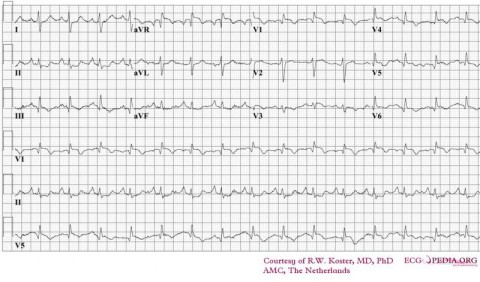
a Coronary angiography b CT pulmonary angiogram c Echocardiography d Cardiac MRI e High resolution CT chest -
15
A 55 year old taxi driver attends the emergency department complaining of chest pain. His pain is central radiating to both shoulders, his jaw, his back and his epigastrium. He is a heavy smoker and has a background history of hyperlipidaemia, hypertension and diabetes. On examination, he looks pale, sweaty, short of breath. His repiratory rate is 25, his blood pressure is 135/90 in the right arm and 110/80 in the left arm. His ECG is shown. What is the most appropriate treatment in this patient ? 
a Labetalol b Metoprolol c Primary angioplasty d DC cardioversion e Digoxin -
16
As a final year medical student, you look for patients to examine before your upcoming final exams. The junior doctor suggests you examine Mr Abdul’s cardiovascular system. During your examination, you find a JVP that is visible but not raised, an impalpable apex beat and distant heart sounds. You look at the ECG (shown). What is the most likely diagnosis ? 
a Cardiac Tamponade b Dextrocardia c Pericarditis d Normal findings e Infective endocarditis secondary to sepsis -
17
An unconscious patient is brought in by ambulance after being found collapsed on the street for an unknown duration. Their clothes are wet from the rain and they are unresponsive but they do have a pulse. An ECG is done in the ambulance (shown). As they are being assessed by the doctor, the cardiac monitor starts showing ventricular tachycardia and their pulse is no longer palpable. CPR is started and 1 shock is given to no avail. Which of the following reversible causes need to be considered in managing this patient’s cardiac arrest ? 
a Hypovolaemia b Hypothermia c Hyperkalaemia d Cardiac tamponade e Tension pneumothorax -
18
You are working in a GP practice when the nurse knocks on your door and asks for your urgent advice about an ECG she has just done on a patient with chest pain. The patient saw one of the GP partners earlier than morning for a dry cough, runny nose and a temperature of 37.6, but also complained of chest which the GP partner suggested he had an ECG for (shown). What is the diagnosis? 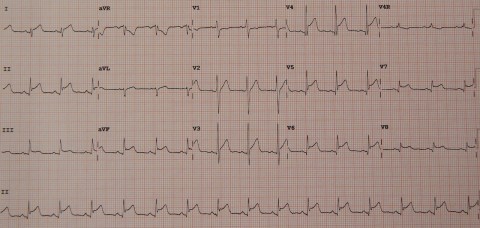
a Atypical pneumonia b Pericarditis c Pulmonary oedema d Acute myocardial infarction e Infective endocarditis -
19
A 56 year old man who is in hospital after having had an anterior resection a week ago. He complains of new onset chest pain. The nurse immediately takes a set of obs, does an ECG and comes running to you with the results. The ECG is shown. What is the likely diagnosis ? 
a Atypical pneumonia b Acute myocardial infarction c Infective endocarditis d Pulmonary embolism e Pericarditis -
20
A 57 year old male is attends the emergency department complaining of sudden onset central chest pain that is severe and sharp in nature. The pain started 2 hours ago and is still ongoing. Lying down makes the pain much worse. He has a history of hypertension, diabetes and recent viral pharyngitis. What is the best treatment for this patient ? 
a Prasugrel b Clopidogrel c Clexane d Fondaparinux e Ibuprofen -
21
Following a car accident, a patient is brought to the emergency department for assessment. They are bruised across the abdomen and chest, tachycardic and tachypnoeaic but are still responsive to voice. As you are carrying out your primary survey, you notice that they stop responding to you. You assess their carotid pulse and find that it is impalpable. The cardiac monitor shows a rhythm identical to their last ECG (shown). You start CPR. What is the most appropriate action as part of resuscitation? 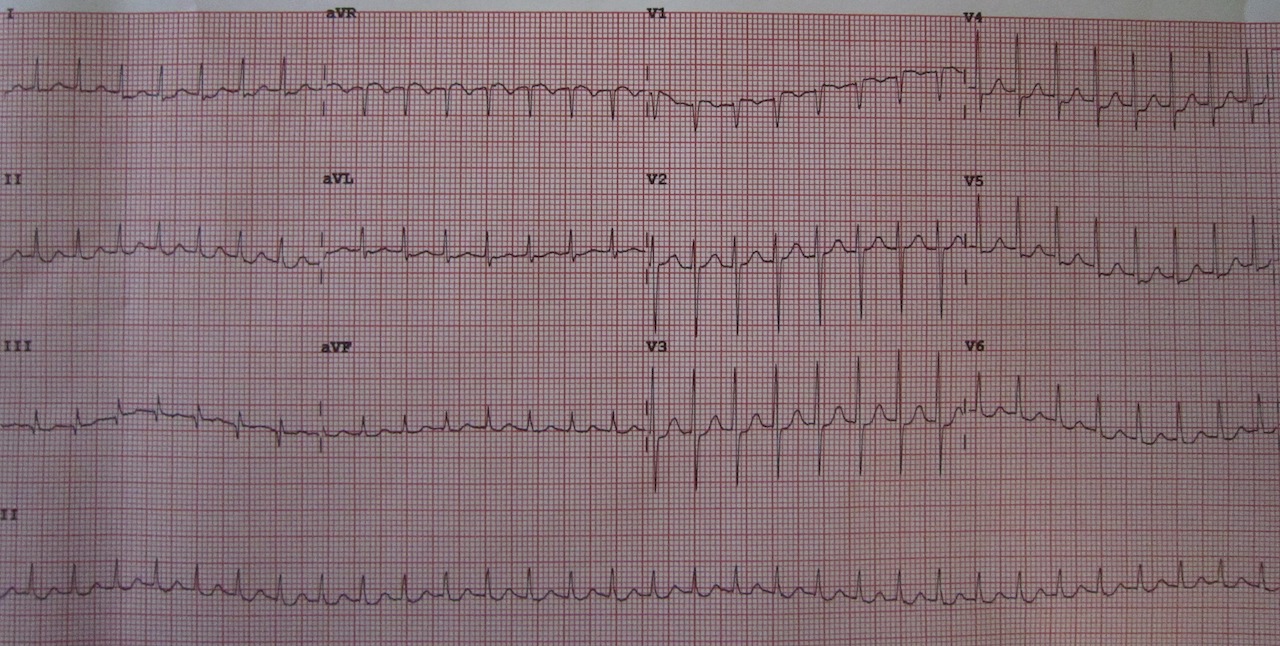
a 300mg Amiodarone b Defibrillation c Bisoprolol for rate control and symptomatic treatment d DC cardioversion to restore sinus rhythm e 1mg Adrenaline -
22
Following a car accident, a patient is brought to the emergency department for assessment. They are bruised across the abdomen and chest, tachycardic and tachypnoeaic but are still responsive to voice. Their ECG is shown. As you are carrying out your primary survey, you notice that they stop responding to you. You assess their carotid pulse and find that it is impalpable. The cardiac monitor shows pulse-less electrical activity. You start CPR. What is the most appropriate action as part of resuscitation ? 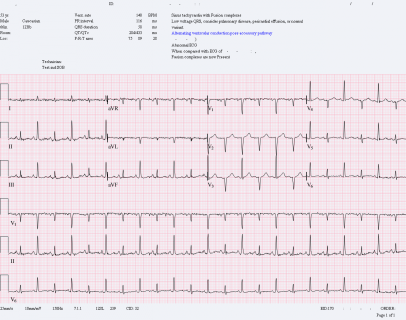
a Revascularisation of Acute myocardial infarction b Drainage of Cardiac Tamponade c IV Abx for Infective endocarditis d Urgent surgery for Aortic dissection e Continue CPR as this is Myocardial contusion -
23
A 51 year old woman attends the emergency department complaining of central sharp chest pain and shortness of breath. She is a tourist from Australia and has only been in the country for two days. Examination reveals right calf tenderness. Her ECG is shown. Which immediate group of mediactions should she be started on ? 
a ADP receptor antagonist b GPVI receptor antagonist c GPIIbIIIa antagonist d Factor Xa inhibitor e Cycloxygenase inhibitor